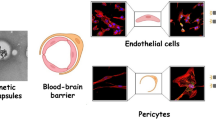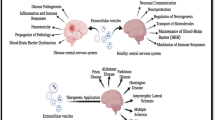Abstract
Rivastigmine hydrogen tartrate (RHT) is an acetylcholinesterase (AChE) inhibitor used in the management of Alzheimer’s disease (AD). RHT is a BCS class-I drug that undergoes significant first-pass metabolism. Permeating a hydrophilic drug through the brain remains a major challenge in brain delivery. In this study, the RHT was incorporated inside the hydrophilic core of liposomes (LPS) and then coated with the ApoE3. ApoE3-coated RHT-loaded liposomes (ApoE3-RHT-LPS) were fabricated through the thin film hydration method using DSPE-PEG. The coating of LPS with ApoE3 enhances brain uptake and improves Aβ clearance. The results obtained from the physicochemical characterization demonstrated that ApoE3-RHT-LPS shows a particle size of 128.6 ± 2.16 nm and a zeta potential of 16.6 ± 1.19. The % entrapment efficiency and % drug loading were found to be 75% and 17.84%, respectively. The data obtained from TEM and SEM studies revealed that the particle size of the LPS was less than 200 nm. An in vitro AChE assay was performed, and the results demonstrated the AChE inhibitory potential of ApoE3-RHT-LPS. Through the intravenous route, an in vivo pharmacokinetic study of formulation displayed improved brain uptake of RHT by ~ 1.3-fold than pure RHT due to ApoE3 coating. In vivo, biodistribution studies in vital organs suggested that the biodistribution of RHT to the liver was significantly reduced (p < 0.001), signifying an increase in the drug’s half-life and blood circulation time. All research findings suggested that ApoE3 coating and LPS strategy are proven effective for improving the brain uptake of RHT designed for the management of AD.









Similar content being viewed by others
Data Availability
The data that support the findings of this study are openly available with the author in the repository.
References
Vaz M, Silvestre S. Alzheimer’s disease: recent treatment strategies. Eur J Pharmacol. 2020;887:173554.
International AD, University M. World Alzheimer Report 2021: Journey through the diagnosis of dementia [Internet]. 2021 [cited 2023 Jun 18]. Available from: https://www.alzint.org/resource/world-alzheimer-report-2021/.
Ashrafian H, Zadeh EH, Khan RH. Review on Alzheimer’s disease: inhibition of amyloid beta and tau tangle formation. Int J Biol Macromol. 2021;167:382–94.
Shamsi TN, Athar T, Parveen R, Fatima S. A review on protein misfolding, aggregation and strategies to prevent related ailments. Int J Biol Macromol. 2017;105:993–1000.
Ullah R, Park TJ, Huang X, Kim MO. Abnormal amyloid beta metabolism in systemic abnormalities and Alzheimer’s pathology: insights and therapeutic approaches from periphery. Ageing Res Rev. 2021;71:101451.
Boche D, Nicoll JAR. Invited Review – Understanding cause and effect in Alzheimer’s pathophysiology: implications for clinical trials. Neuropathol Appl Neurobiol. 2020;46:623–40.
Agatonovic-Kustrin S, Kettle C, Morton DW. A molecular approach in drug development for Alzheimer’s disease. Biomed Pharmacother. 2018;106:553–65.
Marucci G, Buccioni M, Ben DD, Lambertucci C, Volpini R, Amenta F. Efficacy of acetylcholinesterase inhibitors in Alzheimer’s disease. Neuropharmacology. 2021;190:108352.
Nguyen TT, Nguyen TTD, Nguyen TKO, Vo TK, Vo VG. Advances in developing therapeutic strategies for Alzheimer’s disease. Biomed Pharmacother. 2021;139:111623.
Guimarães D, Cavaco-Paulo A, Nogueira E. Design of liposomes as drug delivery system for therapeutic applications. Int J Pharm. 2021;601:120571.
Li M, Du C, Guo N, Teng Y, Meng X, Sun H, et al. Composition design and medical application of liposomes. Eur J Med Chem. 2019;164:640–53.
Gajbhiye KR, Pawar A, Mahadik KR, Gajbhiye V. PEGylated nanocarriers: a promising tool for targeted delivery to the brain. Colloids Surf B Biointerfaces. 2020;187:110770.
Pandian SRK, Vijayakumar KK, Murugesan S, Kunjiappan S. Liposomes: an emerging carrier for targeting Alzheimer’s and Parkinson’s diseases. Heliyon. 2022;8:e09575.
Large DE, Abdelmessih RG, Fink EA, Auguste DT. Liposome composition in drug delivery design, synthesis, characterization, and clinical application. Adv Drug Deliv Rev. 2021;176:113851.
Song Q, Huang M, Yao L, Wang X, Gu X, Chen J, et al. Lipoprotein-based nanoparticles rescue the memory loss of mice with Alzheimer’s disease by accelerating the clearance of amyloid-beta. ACS Nano [Internet]. 2014 [cited 2023 Jun 18];8:2345–59. Available from: https://pubs.acs.org/doi/full/10.1021/nn4058215.
Aleshkov S, Abraham CR, Zannis VI. Interaction of nascent apoe2, apoe3, and apoe4 isoforms expressed in mammalian cells with amyloid peptide β (1-40). Relevance to Alzheimer’s disease. Biochemistry [Internet]. 1997 [cited 2023 Jun 18];36:10571–80. Available from: https://pubs.acs.org/doi/full/10.1021/bi9626362.
Nguyen K, Hoffman H, Chakkamparambil B, Grossberg GT. Evaluation of rivastigmine in Alzheimer’s disease. Neurodegener Dis Manag. 2020;11:35–48.
Yang Z. Preparation and evaluation of rivastigmine liposomes for intranasal delivery BT - liposome-based drug delivery systems. In: Lu W-L, Qi X-R, editors. Berlin. Heidelberg: Springer, Berlin Heidelberg; 2021. p. 325–44.
El-Helaly SN, Elbary AA, Kassem MA, El-Nabarawi MA. Electrosteric stealth Rivastigmine loaded liposomes for brain targeting: preparation, characterization, ex vivo, bio-distribution and in vivo pharmacokinetic studies. Drug Deliv. 2017;24:692–700.
Rotman M, Welling MM, Bunschoten A, de Backer ME, Rip J, Nabuurs RJA, et al. Enhanced glutathione PEGylated liposomal brain delivery of an anti-amyloid single domain antibody fragment in a mouse model for Alzheimer’s disease. J Control Release. 2015;203:40–50.
Krishna KV, Wadhwa G, Alexander A, Kanojia N, Saha RN, Kukreti R, et al. Design and biological evaluation of lipoprotein-based donepezil nanocarrier for enhanced brain uptake through oral delivery. ACS Chem Neurosci. 2019;10:4124–35.
Bradford MM. A rapid and sensitive method for the quantitation of microgram quantities of protein utilizing the principle of protein-dye binding. Anal Biochem. 1976;72:248–54.
Yang T, Choi M-K, Cui F-D, Kim JS, Chung S-J, Shim C-K, et al. Preparation and evaluation of paclitaxel-loaded PEGylated immunoliposome. J Control Release. 2007;120:169–77.
Krishna KV, Saha RN, Dubey SK. Biophysical, biochemical, and behavioral implications of ApoE3 conjugated donepezil nanomedicine in a Aβ1-42induced Alzheimer’s disease rat model. ACS Chem Neurosci. 2020;11:4139–51.
Bibi S, Kaur R, Henriksen-Lacey M, McNeil SE, Wilkhu J, Lattmann E, et al. Microscopy imaging of liposomes: from coverslips to environmental SEM. Int J Pharm. 2011;417:138–50.
Li T, Nowell CJ, Cipolla D, Rades T, Boyd BJ. Direct comparison of standard transmission electron microscopy and cryogenic-TEM in imaging nanocrystals inside liposomes. Mol Pharm [Internet]. 2019 [cited 2022 Oct 3];16:1775–81. Available from: https://pubs.acs.org/doi/abs/10.1021/acs.molpharmaceut.8b01308.
Hubin E, Verghese PB, van Nuland N, Broersen K. Apolipoprotein E associated with reconstituted high-density lipoprotein-like particles is protected from aggregation. FEBS Lett [Internet]. 2019 [cited 2022 Oct 3];593:1144–53. Available from: https://onlinelibrary.wiley.com/doi/full/10.1002/1873-3468.13428.
Whitmore L, Wallace BA. Protein secondary structure analyses from circular dichroism spectroscopy: methods and reference databases. Biopolymers. 2008;89:392–400.
Mulik RS, Mönkkönen J, Juvonen RO, Mahadik KR, Paradkar AR. ApoE3 mediated polymeric nanoparticles containing curcumin: apoptosis induced in vitro anticancer activity against neuroblastoma cells. Int J Pharm. 2012;437:29–41.
Aleskndrany A, Sahin I. The effects of Levothyroxine on the structure and dynamics of DPPC liposome: FTIR and DSC studies. Biochimica et Biophysica Acta (BBA) - Biomembranes. 2020;1862:183245.
Farooq MA, Xinyu H, Jabeen A, Ahsan A, Seidu TA, Kutoka PT, et al. Enhanced cellular uptake and cytotoxicity of vorinostat through encapsulation in TPGS-modified liposomes. Colloids Surf B Biointerfaces. 2021;199:111523.
Cheng Y, Zou T, Dai M, He XY, Peng N, Wu K, et al. Doxorubicin loaded tumor-triggered targeting ammonium bicarbonate liposomes for tumor-specific drug delivery. Colloids Surf B Biointerfaces. 2019;178:263–8.
Fernandes M, Lopes I, Magalhães L, Sárria MP, Machado R, Sousa JC, et al. Novel concept of exosome-like liposomes for the treatment of Alzheimer’s disease. J Control Release. 2021;336:130–43.
Liu DM, Xu B, Dong C. Recent advances in colorimetric strategies for acetylcholinesterase assay and their applications. TrAC Trends Anal Chem. 2021;142:116320.
ElKady EF, Mostafa EA. Validated LC/MS/MS Method for the determination of rivastigmine in human plasma: application to a pharmacokinetic study in Egyptian volunteers to determine the effect of gender and body mass index. J Chromatogr Sci [Internet]. 2023 [cited 2023 Aug 20];61:453–60. Available from: https://pubmed.ncbi.nlm.nih.gov/35750040/.
Kreuter J. Drug delivery to the central nervous system by polymeric nanoparticles: what do we know? Adv Drug Deliv Rev [Internet]. 2014 [cited 2023 Aug 20];71:2–14. Available from: https://pubmed.ncbi.nlm.nih.gov/23981489/.
Juhairiyah F, de Lange ECM. Understanding drug delivery to the brain using liposome-based strategies: studies that provide mechanistic insights are essential. AAPS J [Internet]. 2021 [cited 2023 Aug 20];23. Available from: https://pmc/articles/PMC8553706/.
Dash S, Murthy P, Nath L, Pharm PC-AP, 2010 undefined. Kinetic modeling on drug release from controlled drug delivery systems. academia.edu [Internet]. [cited 2023 Jul 20]; Available from: https://www.academia.edu/download/61513061/Dash__Murthy_201020191214-52263-1z0h7e0.pdf.
Mathematical models of drug release. Strategies to modify the drug release from pharmaceutical systems. Elsevier; 2015. p. 63–86.
Acknowledgements
The authors would like to acknowledge the research funding support by the Department of Pharmaceuticals (DoP), Ministry of Chemicals and Fertilizers, Govt. of India, to National Institute of Pharmaceutical Education and Research (NIPER) Raebareli, India. The Institutional Animal Ethics Committee No is NIPER/RBL/118/AUG 2023. The NIPER-R communication number for the research article is NIPER-R/Communication/465.
Author information
Authors and Affiliations
Contributions
Dr. Rahul Shukla: supervision, conceptualization, methodology, and investigation; Pooja khairnar: writing original draft, methodology, validation, visualization, data curation, analysis, and data interpretation; Ajit Singh: editing and investigation; and Kailash Ahirwar: editing and investigation.
Corresponding author
Ethics declarations
Conflict of Interest
The authors declare no competing interests.
Additional information
Publisher's Note
Springer Nature remains neutral with regard to jurisdictional claims in published maps and institutional affiliations.
Supplementary Information
Below is the link to the electronic supplementary material.
Rights and permissions
Springer Nature or its licensor (e.g. a society or other partner) holds exclusive rights to this article under a publishing agreement with the author(s) or other rightsholder(s); author self-archiving of the accepted manuscript version of this article is solely governed by the terms of such publishing agreement and applicable law.
About this article
Cite this article
Khairnar, P., Singh, A., Ahirwar, K. et al. ApoE3 Anchored Liposomal Delivery of Rivastigmine for Brain Delivery: Formulation, Characterization, and In Vivo Pharmacokinetic Evaluation. AAPS PharmSciTech 24, 223 (2023). https://doi.org/10.1208/s12249-023-02684-8
Received:
Accepted:
Published:
DOI: https://doi.org/10.1208/s12249-023-02684-8




